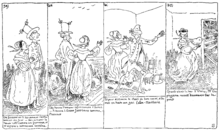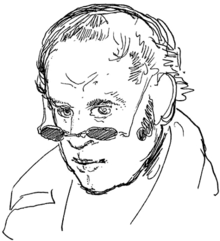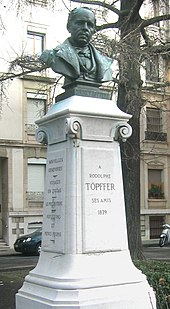Rodolphe Töpffer
Rodolphe Töpffer , also written Toepffer (born January 31 or February 1, 1799 in Geneva , † June 8, 1846 in Geneva) was a French-speaking Swiss draftsman and novelist . He is best known for his picture stories, which are considered to be the pioneers of comics .
Life
Rodolphe Töpffer was the son of the painter Wolfgang Adam Töpffer , whose father (Georges-Christophe Töpffer) had emigrated from Germany.
Töpffer had to give up his original wish to become a painter because of an eye problem. Instead, he began teaching Latin and Greek in a private school in 1820. In 1823 he married Anne-Marie Moulinié (1801–1857), with whom he had four children: Adèle (1827–1910), François (1830–1870), Charles (1832–1905), Esther (1839–1909).
Thanks to his wife's dowry, he opened a boys' boarding school in Geneva in 1825. Inspired by the ideas of Jean-Jacques Rousseau , he organized excursions and soon larger study trips with his students. In the first half of the 19th century they mostly traveled on foot in Switzerland, Italy and neighboring France. These trips are described in the Voyages en zig-zag . In 1832 he received the chair for rhetoric and literature at the Geneva Academy (predecessor of Geneva University ).
From 1834 he was a conservative member of the parliament of the canton of Geneva . He fought against the liberal bourgeoisie and the tribune James Fazy ( caricatured in Histoire d'Albert ), who with the revolution of 1842–1846 definitely abolished the old patrician system in the canton of Geneva.
Pioneer of the comic medium
In his spare time, Töpffer drew comical, sometimes bizarre picture stories. After Johann Wolfgang von Goethe had praised his Faust parody Dr Festus , and at the urging of his friends, Töpffer's picture stories were published from 1833 and quickly became popular. In these stories he caricatured the customs of good society ( Histoire de Monsieur Jabot. Imp. Caillet, Geneva 1833), teaching methods ( Monsieur Crépin ), scientists ( Voyages et aventures du Dr Festus ) and politicians ( Histoire d ' Albert , Monsieur Pencil ).
Goethe once said (Eckermann, January 4, 1831) about Töpffer:
- It is really too great! It all sparkles of talent and spirit! Some leaves are absolutely unsurpassable! If, in future, he chose a less frivolous subject and pulled himself together a little more, he would do things that were beyond all concepts. (...) Töpffer seems to me (...) to stand on my own two feet and to be as completely original as only one talent has ever occurred to me.
With these picture stories, Töpffer is the founder of a tradition that leads through picture sheets (e.g. Neuruppiner Bilderbogen , Münchener Bilderbogen ), the work of Wilhelm Busch and under the influence of American comics to European comics .
Töpffer was one of the first to combine the technology of panels , i.e. individual images, with a caricature style of drawing. He also experimented with different picture sizes to convey a sense of time.

• «She lets her lover admire the shining star of the day. You lover will find it round like cheese and pleasant like a lantern. "
• «She finds love as infinite as the sea. He finds the sea boring like love. "
• "To entertain the chosen one of her heart, she organizes a cheerful blind man's buff."
• "When it is Elvire's turn, Monsieur Cryptogame goes quietly up to the deck."
He gained his reputation as a writer with the romantic short stories (Le presbytère; La bibliothèque de mon oncle; L'héritage; Le col d'Anterne; Le lac de Gers; La vallée de Trient; La traversée; Le Grand Saint-Bernard; La peur; Elisa et Widmer) , which are collected in the Nouvelles Genevoises . Most of his writings are illustrated with drawings, especially the Voyages en zig-zag .
Works
Picture stories
- Les Amours de Monsieur Vieux-Bois (1827)
- Voyages et aventures du Dr Festus (1829)
- Histoire de Monsieur Cryptogame (1830)
- Histoire de Monsieur Jabot (Imp.Caillet, Geneve 1833)
- Monsieur Pencil (1831)
- Monsieur Crépin (1837)
- Histoire d'Albert , also called Histoire de Jacques (1844)
- Essai de Physiognomonie (1845) treatise on his drawing method
(The year of creation is given, not the year of first publication.)
Fonts
- La bibliothèque de mon oncle (1832, German My uncle's library , Leipzig 1847)
- Excursion dans les Alpes, 1832 (1833)
- Le Presbytère (1832, German The rectory )
- Nouvelles genevoises (1841 *) , German Geneva novellas, among others by Heinrich Zschokke , Aarau 1839 and Stuttgart 1885))
- Voyages en zig-zag (1843 *) )
- Rosa et Gertrude (1847, German Rosa and Gertrud , Hildburghausen 1865)
- Réflexions et menus propos d'un peintre genevois (1830–1848)
- Nouveaux Voyages en zig-zag (1854 *) )
*) Individual novellas or travelogues were published earlier.
expenditure
- Œuvres complètes . Edition d'Art Albert Skira, Geneva 1943
- Comic picture novels 1 , Comic picture novels 2 . Two volumes with a total of six stories (Monsieur Jabot, Monsieur Crepin, Monsieur Vieux Bois, Docteur Festus, Monsieur Pencil, Monsieur Cryptogame. Only the "Histoire d'Albert" is missing). Insel Verlag Leipzig, no year [1967].
- Funny picture novels . 2 volumes, Herbig, Berlin a. a. without year
See also the complete list of editions of the picture stories.
literature
- Eugène Rambert : Écrivains nationaux suisses, vol 1 . Geneva 1874.
- Pierre M. Relave: La vie et les oeuvres de Töpffer. Apres des documents inédits. Hachette, Paris 1886.
- Auguste Blondel, Paul Mirabaud: Rodolphe Töpffer. L'écrivain, l'artiste et l'homme. Hachette, Paris 1887.
- Töpffer, Rudolf . In: Meyers Konversations-Lexikon . 4th edition. Volume 15, Verlag des Bibliographisches Institut, Leipzig / Vienna 1885–1892, p. 756.
- Ernst Gallati: Rodolphe Töpffer and the German-speaking culture ( studies in German, English and comparative literature; vol. 32). Bouvier, Bonn 1976, ISBN 3-416-01026-4 .
- Eckart Sackmann : Rodolphe Töpffers influences in the German-speaking area. In the S. (Ed.): Deutsche Comicforschung 2005. Comicplus, Hildesheim 2004, ISBN 3-89474-144-9 , pp. 12-21.
- Keyvan Sarkhosh: "Strange collections of drawings of caricatured heads and scenes into a comical heroic poem". The genesis of the comic medium and its specifics in Rodolphe Töpffer (1799-1846). In: Comparative Literature. Yearbook of the German Society for General and Comparative Literature 2011. ISBN 978-3-939381-40-2 , pp. 45–67.
- Joël Aguet: Rodolphe Töpffer . In: Andreas Kotte (Ed.): Theater Lexikon der Schweiz - Dictionnaire du théâtre en Suisse. Volume 3, Chronos, Zurich 2005, ISBN 3-0340-0715-9 , pp. 1954–1956. (French)
- David Kunzle: Father of the comic strip. Rodolphe Töpffer. University Press, Jackson, Miss. 2007, ISBN 978-1-57806-947-7 .
- Philippe Kaenel: Le métier d'illustrateur 1830–1880. Rodolphe Töpffer, J.-J. Grandville , Gustave Doré . Edition Messene, Paris 1996, ISBN 2-911043-08-1 (also dissertation, University of Lausanne 1994).
Web links
- Literature by and about Rodolphe Töpffer in the catalog of the German National Library
- Works by and about Rodolphe Töpffer in the German Digital Library
- Philippe Kaenel: Rodolphe Töpffer. In: Historical Lexicon of Switzerland .
- Philippe Kaenel: Töpffer, Rodolphe. In: Sikart
- Works by Rodolphe Töpffer at Zeno.org .
- Works by Rodolphe Töpffer in the Gutenberg-DE project
- Rodolphe Töpffer in the Internet Archive
- An online version of his first picture story, Les Amours de Monsieur Vieux-Bois
- Images and texts from Voyages en zigzag, ou excursions dun pensionnat en vacances dans les cantons suisses et sur le revers italien des Alpes by Rodolphe Töpffer in the VIATIMAGES portal
Individual evidence
- ↑ Wolfgang Adam Töpffer (portrait) on Commons
- ↑ Rodolphe Töpffer's photo report on the school hike in 1838 with his students In: Zürcher Illustrierte , Vol. 16, Issue 31, 1940, pp. 835–837.
- ↑ on www.dnb.de
| personal data | |
|---|---|
| SURNAME | Töpffer, Rodolphe |
| BRIEF DESCRIPTION | Swiss draftsman and novelist |
| DATE OF BIRTH | January 31, 1799 |
| PLACE OF BIRTH | Geneva |
| DATE OF DEATH | June 8, 1846 |
| Place of death | Geneva |

